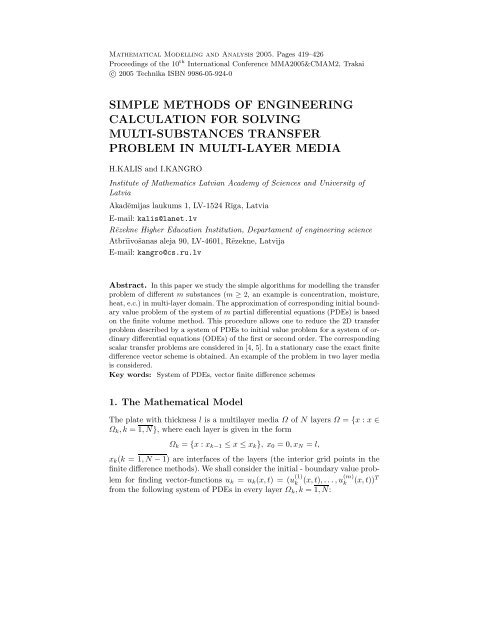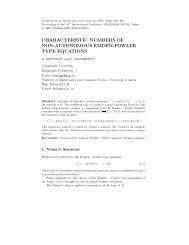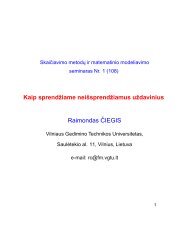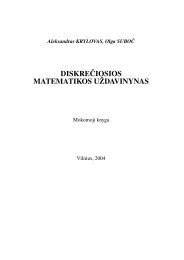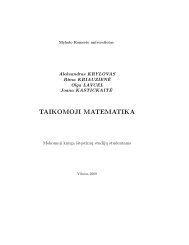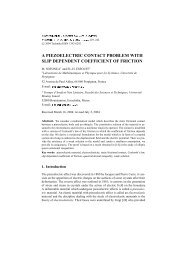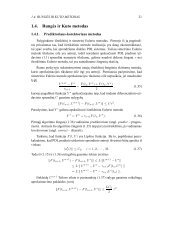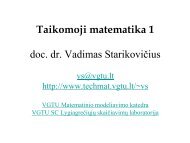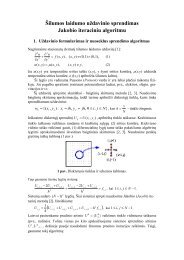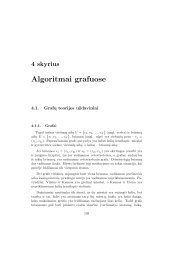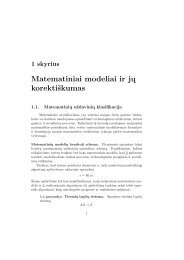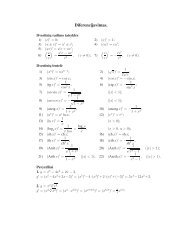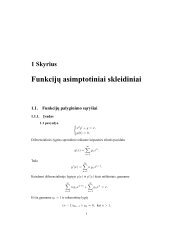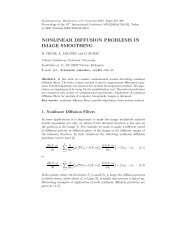simple methods of engineering calculation for solving multi ...
simple methods of engineering calculation for solving multi ...
simple methods of engineering calculation for solving multi ...
You also want an ePaper? Increase the reach of your titles
YUMPU automatically turns print PDFs into web optimized ePapers that Google loves.
Mathematical Modelling and Analysis 2005. Pages 419–426<br />
Proceedings <strong>of</strong> the 10 th International Conference MMA2005&CMAM2, Trakai<br />
c○ 2005 Technika ISBN 9986-05-924-0<br />
SIMPLE METHODS OF ENGINEERING<br />
CALCULATION FOR SOLVING<br />
MULTI-SUBSTANCES TRANSFER<br />
PROBLEM IN MULTI-LAYER MEDIA<br />
H.KALIS and I.KANGRO<br />
Institute <strong>of</strong> Mathematics Latvian Academy <strong>of</strong> Sciences and University <strong>of</strong><br />
Latvia<br />
Akadēmijas laukums 1, LV-1524 Rīga, Latvia<br />
E-mail: kalis@lanet.lv<br />
Rēzekne Higher Education Institution, Departament <strong>of</strong> <strong>engineering</strong> science<br />
Atbrīivoŝanas aleja 90, LV-4601, Rēzekne, Latvija<br />
E-mail: kangro@cs.ru.lv<br />
Abstract. In this paper we study the <strong>simple</strong> algorithms <strong>for</strong> modelling the transfer<br />
problem <strong>of</strong> different m substances (m ≥ 2, an example is concentration, moisture,<br />
heat, e.c.) in <strong>multi</strong>-layer domain. The approximation <strong>of</strong> corresponding initial boundary<br />
value problem <strong>of</strong> the system <strong>of</strong> m partial differential equations (PDEs) is based<br />
on the finite volume method. This procedure allows one to reduce the 2D transfer<br />
problem described by a system <strong>of</strong> PDEs to initial value problem <strong>for</strong> a system <strong>of</strong> ordinary<br />
differential equations (ODEs) <strong>of</strong> the first or second order. The corresponding<br />
scalar transfer problems are considered in [4, 5]. In a stationary case the exact finite<br />
difference vector scheme is obtained. An example <strong>of</strong> the problem in two layer media<br />
is considered.<br />
Key words: System <strong>of</strong> PDEs, vector finite difference schemes<br />
1. The Mathematical Model<br />
The plate with thickness l is a <strong>multi</strong>layer media Ω <strong>of</strong> N layers Ω = {x : x ∈<br />
Ω k , k = 1, N}, where each layer is given in the <strong>for</strong>m<br />
Ω k = {x : x k−1 ≤ x ≤ x k }, x 0 = 0, x N = l,<br />
x k (k = 1, N − 1) are interfaces <strong>of</strong> the layers (the interior grid points in the<br />
finite difference <strong>methods</strong>). We shall consider the initial - boundary value problem<br />
<strong>for</strong> finding vector-functions u k = u k (x, t) = (u (1)<br />
k<br />
(x, t), . . . , u(m)<br />
k<br />
(x, t)) T<br />
from the following system <strong>of</strong> PDEs in every layer Ω k , k = 1, N:
420 H.Kalis, I.Kangro<br />
G k<br />
∂u k<br />
∂t<br />
= ∂ (<br />
∂x<br />
L k<br />
∂u k<br />
∂x<br />
)<br />
− Q k , x ∈ Ω, t > 0, (1.1)<br />
where G k is a quadratic matrix m × m with constant elements γ (i,j)<br />
k<br />
such<br />
that det(G k ) ≠ 0, L k is a quadratic positive definite matrix m × m with<br />
constant elements l (i,j)<br />
k<br />
, Q k is vector-column m × 1 with constant elements<br />
q (j)<br />
k<br />
, i, j = 1, m.<br />
The system <strong>of</strong> PDEs (1.1) can be rewritten in the following <strong>for</strong>m:<br />
∂<br />
(<br />
∂u k (x, t)<br />
)<br />
L k = F k , k = 1, N, (1.2)<br />
∂x ∂x<br />
where F k = G k ˙u k (x, t) + Q k , ˙u k = ∂u k<br />
. We have the following continuity<br />
∂t<br />
conditions on the interior surfaces x = x k , k = 1, N − 1 :<br />
{<br />
uk (x k , t) = u k+1 (x k , t)<br />
L k u ′ k (x k, t) = L k+1 u ′ k+1 (x (1.3)<br />
k, t),<br />
and boundary conditions on the exterior surfaces x = x 0 = 0, x = x N = l :<br />
{<br />
L1 u ′ 1(0, t) = α 0 (u 1 (0, t) − T 0 )<br />
L N u ′ N (l, t) = α (1.4)<br />
l(T l − u N (l, t)),<br />
where u ′ = ∂u<br />
∂x , α 0, α l are diagonal-matrixes with constant elements<br />
α (j)<br />
0 , α(j) l<br />
, j = 1, m,<br />
T 0 , T l are known vector-functions with elements T (j) (j)<br />
0 (t), T<br />
l<br />
(t), j = 1, m.<br />
For the initial condition at t = 0 we define<br />
u k (x, 0) = φ(x), k = 1, N, (1.5)<br />
where φ is known vector-column. If the elements <strong>of</strong> matrix α 0 or α l are equal<br />
to infinity (α 0 = ∞, or α l = ∞, ) then we have the first kind boundary<br />
conditions<br />
u 1 (0, t) = T 0 , u N (l, t) = T l . (1.6)<br />
2. The 2-Layer Problem and Approximation <strong>of</strong> Integrals<br />
Using the method <strong>of</strong> finite volumes <strong>for</strong> scalar functions (see [3]) we obtain<br />
the following exact vector finite-difference scheme with respect to grid points<br />
x k , k = 0, N and given function F k [5]:<br />
L 1 h −1<br />
1 (u 1 − u 0 ) − α 0 (u 0 − T 0 ) = ¯R + 0 , (2.1)
Simple Methods <strong>for</strong> Solving Multi-Substances Problem 421<br />
L k+1 h −1<br />
k+1 (u k+1 − u k ) − L k h −1<br />
k (u k − u k−1 ) = ¯R k , k = 1, N − 1, (2.2)<br />
α l (T l − u N ) − L N h −1<br />
N (u N − u N−1 ) = ¯R − N . (2.3)<br />
The right side <strong>of</strong> expressions R ± k contain integrals <strong>of</strong> derivatives u k(x, t). In the<br />
stationary case ˙u k = 0 this scheme is exact. For non-stationary problem ˙u k ≠<br />
0, to approximate the integrals we considered different quadrature <strong>for</strong>mulas<br />
[5].<br />
Now we restrict to the case <strong>of</strong> only two layers, that is<br />
N = 2, x 1 = h 1 , x 2 = l = h 1 + h 2 , α 0 = ∞, u 0 = T 0 .<br />
Then the unknown vector-functions are u 1 , u 2 . In the non-stationary case the<br />
finite-difference scheme is given by<br />
{<br />
L2 h −1<br />
2 (u 2 − u 1 ) − L 1 h −1<br />
1 (u 1 − T 0 ) = G 2 R + 1 + G 1R − 1 + I 1<br />
α l (T l − u 2 ) − L 2 h −1<br />
2 (u 2 − u 1 ) = G 2 R −1<br />
2 + I − 2 , (2.4)<br />
where I 1 = I − 1<br />
+ I+ 1 , and<br />
R − 1<br />
= 1 ∫ h1<br />
x ˙u 1 (x, t) dx = h 1 J 3 , R 1<br />
+ h 1<br />
0<br />
= 1 h 2<br />
∫ l<br />
h 1<br />
(l − x) ˙u 2 (x, t) dx = h 2 J 1 ,<br />
R − 2<br />
= 1 ∫ l<br />
(x − h 1 ) ˙u 2 (x, t) dx = h 2 J 2 , J 1 =<br />
h 2 h 1<br />
∫ 1<br />
0<br />
(1 − ¯x)V 2 (¯x) d¯x,<br />
J 2 =<br />
J 3 =<br />
∫ 1<br />
0<br />
∫ 1<br />
0<br />
¯xV 2 (¯x) d¯x, ¯x = x − h 1<br />
h 2<br />
, V 2 (¯x) = ˙u 2 (h 1 + h 2¯x, t),<br />
¯xV 1 (¯x) d¯x, ¯x = x h 1<br />
, V 1 (¯x) = ˙u 1 (h 1¯x, t).<br />
In the non-stationary case we compute integrals J j , j = 1, 2, 3 approximately<br />
with quadrature <strong>for</strong>mulas in the following way (j = 1, 2):<br />
J j =A (j)<br />
1 V 2(0) + A (j)<br />
2 V 2(1) + A (j)<br />
3 V 2 ′<br />
J 3 = A (3)<br />
1 V 1(0) + A (3)<br />
2 V 1(1) + B (3)<br />
where <strong>for</strong> j = 1, 2:<br />
1 V 1 ′′<br />
(1) + B(j)<br />
1 V 2 ′′<br />
(0) + B(j)<br />
2 V ′′<br />
2 (1) + r j, (2.5)<br />
(0) + B(3) 2 V 1 ′′ (1) + r 3, (2.6)<br />
r j = h5 2 ∂ 5 ˙u 2 (ξ j , t)<br />
5! ∂x 5 C j , ξ j ∈ (h 1 , l), r 3 = h4 1 ∂ 4 ˙u 1 (ξ 3 , t)<br />
4! ∂x 4 C 3 , ξ 3 ∈ (0, h 1 )<br />
are the vector-errors terms, A (j)<br />
k<br />
, B(j) k<br />
, C j(j, k = 1, 2, 3) are the indefinite coefficients.<br />
Using the power functions ¯x i , i = 0, 1, ... in (2.5)–(2.6) similarly the scalar<br />
case [3] <strong>for</strong> the fixed coordinates <strong>of</strong> vectors V 1 (¯x), V 2 (¯x) we get the following<br />
two systems <strong>of</strong> linear algebraic equations <strong>for</strong> A (j)<br />
k<br />
, B(j) k<br />
:
422 H.Kalis, I.Kangro<br />
⎧<br />
⎪⎨<br />
⎪⎩<br />
and<br />
1<br />
(i + 1)(i + 2) = A(1) 1 0i + A (1)<br />
2 + iA (1)<br />
3 + i(i − 1)(B (1)<br />
1 0i−2 + B (1)<br />
2 ),<br />
(2.7)<br />
1<br />
i + 2 = A(2) 1 0i + A (2)<br />
2 + iA (2)<br />
3 + i(i − 1)(B (2)<br />
1 0i−2 + B (2)<br />
2 ), i = 0, 4,<br />
1<br />
i + 2 = A(3) 1 0i + A (3)<br />
2 + i(i − 1)(B (3)<br />
1 0i−2 + B (3)<br />
2 ), i = 0, 3, (2.8)<br />
where 0 i = 1 <strong>for</strong> i ≤ 0.<br />
Simple computations show that the solutions <strong>of</strong> the corresponding systems<br />
(2.7) – (2.8) are given by<br />
A (1)<br />
1 = 7<br />
30 , A(1) 2 = 4 15 , A(1) 3 = − 1 10 , B(1) 1 = − 1<br />
180 , B(1) 2 = 1<br />
72 ,<br />
A (2)<br />
1 = 1<br />
15 , A(2) 2 = 13<br />
30 , A(2) 3 = − 1 10 , B(2) 1 = − 1<br />
360 , B(2) 2 = 1<br />
90 ,<br />
A (3)<br />
1 = 1 6 , A(3) 2 = 1 3 , B(3) 1 = − 7<br />
360 , B(3) 2 = − 1 45 .<br />
Constants C j in the residual r j are determined using power functions ¯x 4<br />
and ¯x 5 :<br />
C 1 = − 13<br />
630 , C 2 = − 4<br />
315 , C 3 = 1<br />
10 .<br />
Using the vector difference equations (2.4) and the right-side integrals<br />
approximations (2.5), (2.6) with neglected error terms r j , j = 1, 3 we have<br />
the following vector system <strong>of</strong> linear ODEs <strong>of</strong> second order ( ˙u 0 = ü 0 = 0,<br />
ü = ∂2 u<br />
∂t 2 , α 0 = ∞) :<br />
⎧<br />
G 2 h 2 [A ⎪⎨<br />
(1)<br />
1 ˙u 1 + (A (1)<br />
2 − h 2 A (1)<br />
3 L−1 2 ) ˙u 2 + h 2 2 B(1) 1 L−1 2 G 2ü 1<br />
+h 2 2<br />
⎪⎩<br />
B(1) 2 L−1 2 G 2ü 2 ] + G 1 h 1 [A (3)<br />
2 ˙u 1 + h 2 1 B(3) 2 L−1 1 G 1ü 1 ] (2.9)<br />
+I 1 = h −1<br />
2 L 2(u 2 − u 1 ) − h −1<br />
1 L 1(u 1 − T 0 ),<br />
⎧<br />
⎨ G 2 h 2 [A (2)<br />
1 ˙u 1 + (A (2)<br />
2 − h 2 A (2)<br />
3 L−1 2 ) ˙u 2 + h 2 2B (2)<br />
1 L−1 2 G 2ü 1<br />
⎩<br />
+h 2 2 B(2) 2 L−1 2 G 2ü 2 ] + I − 2 = α l(T l − u 2 ) − h −1<br />
2 L 2(u 2 − u 1 ).<br />
The initial conditions <strong>for</strong> ODEs (2.9), (2.10) are given by<br />
{<br />
u1 (0) = φ(h 1 ), u 2 (0) = φ(l), ˙u 1 (0) = G −1<br />
1 (L 1φ ′′ (h 1 ) − Q 1 ),<br />
˙u 2 (0) = G −1<br />
2 (L 2φ ′′ (l) − Q 2 ).<br />
(2.10)<br />
(2.11)<br />
Here one should take in account that from (1.1)–(1.6) it follows:
Simple Methods <strong>for</strong> Solving Multi-Substances Problem 423<br />
2 (1) = h ∂<br />
2<br />
∂x ˙u 2(l, t) = −h 2 L −1<br />
2 α l ˙u 2 ,<br />
V ′<br />
1 (0) = h2 1<br />
∂x 2 ˙u 1(0, t) = h 2 ∂<br />
1<br />
V ′′<br />
V ′′<br />
∂ 2<br />
∂ 2<br />
∂t u′′<br />
1 (1) = h 2 1<br />
∂x 2 ˙u 1(h 1 , t) = h 2 1L −1<br />
1 G 1ü 1 ,<br />
1 (0, t) = h2 1 L−1 1 G 1ü 0 ,<br />
V ′′<br />
2 (0) = h2 2 L−1 2 G 2ü 1 , V ′′<br />
2 (1) = h2 2 L−1 2 G 2ü 2 .<br />
Remark 1. If α 0 = α l = ∞, u 0 = T 0 , u 2 = T l , then the vector finite–difference<br />
equation follows from (2.4):<br />
where<br />
h −1<br />
2 L 2(T l − u 1 ) − h −1<br />
1 L 1(u 1 − T 0 ) = G 2 h 2 J 1 + G 1 h 1 J 3 + I 1 , (2.12)<br />
J 1 = A (1)<br />
1 V 2(0) + A (1)<br />
2 V 2(1) + B (1)<br />
1 V ′′<br />
2 (0) + B (1)<br />
2 V ′′<br />
2 (1) + r 1 ,<br />
r 1 = h4 2 ∂ 4 ˙u 2 (ξ 1 , t)<br />
4! ∂x 4 C 1 , ξ 1 ∈ (h 1 , l),<br />
A (1)<br />
1 = 1 3 , A(1) 2 = 1 6 , B(1) 1 = − 1<br />
45 , B(1) 2 = − 7<br />
360 , C 1 = 1<br />
10 .<br />
There<strong>for</strong>e the system <strong>of</strong> ODEs <strong>of</strong> second order ( ˙u 0 = ˙u 2 = 0, ü 0 = ü 2 = 0) is<br />
given in the following <strong>for</strong>m<br />
⎧<br />
⎨ G 2 h 2 [A (1)<br />
1 ˙u 1 + h 2 2B (1)<br />
1 L−1 2 G 2ü 1 ] + G 1 h 1 [A (3)<br />
2 ˙u 1<br />
⎩<br />
+h 2 1 B(3) 2 L−1 1 G 1ü 1 ] + I 1 = h −1<br />
2 L 2(T l − u 1 ) − h −1<br />
1 L 1(u 1 − T 0 ).<br />
(2.13)<br />
If integrals J 1 , J 3 are approximated without the derivatives then we get<br />
the following system <strong>of</strong> ODEs <strong>of</strong> first order<br />
1<br />
3 (h 2G 2 + h 1 G 1 ) ˙u 1 + I 1 = h −1<br />
2 L 2(T l − u 1 ) − h −1<br />
1 L 1(u 1 − T 0 ). (2.14)<br />
3. Some Numerical Results and Examples<br />
Example 1. Let assume that<br />
m = 2, Q 1 = Q 2 = 0, L 1 = L 2 = L, T 0 = T l = 0, G 1 = G 2 = G, l = 1,<br />
φ(x) = (sin(πx), sin(πx) T , h 1 = h 2 = h = 0.5,<br />
( ) ( ) ( 1 0<br />
1 0<br />
L = E = , G = , G 2 1 0<br />
=<br />
0 1<br />
1 1<br />
2 1<br />
)<br />
, G −1 =<br />
( ) 1 0<br />
,<br />
−1 1<br />
then the exact solution <strong>of</strong> PDEs problem (1.1)–(1.6) is given by
424 H.Kalis, I.Kangro<br />
u(x, t) = (exp(−π 2 t) sin(πx), exp(−π 2 t)(1 + π 2 t) sin(πx)) T ,<br />
u 1 = u(h, t) = (exp(−π 2 t), exp(−π 2 t)(1 + πt)) T .<br />
This is the solution <strong>of</strong> ODEs<br />
Gü 1 = πu 1 .<br />
From the first order ODEs (2.14) we get the vector initial-value problem<br />
G ˙u 1 = −12u 1 , u 1 (0) = (1, 1) T ,<br />
and the solutions with error O(h 2 ) is given by<br />
u 1 = u(h, t) = ( exp(−12t), exp(−12t)(1 + 12t) ) T<br />
.<br />
There<strong>for</strong>e the value π 2 is replaced with 12.<br />
From second order ODEs (2.13) we get the following initial-value problem<br />
{<br />
b1 G 2 ü 1 + a 1 G ˙u 1 + u 1 = 0<br />
(3.1)<br />
u 1 (0) = (1, 1) T , ˙u 1 (0) = −G −1 (π 2 , π 2 ) T = (−π 2 , 0) T ,<br />
where<br />
b 1 = 0.5h 4 (B (1)<br />
1 + B (3)<br />
2 ) = 89<br />
11520 , a 1 = 0.5h 2 (A (1)<br />
1 + A (3)<br />
3 ) = 7<br />
48 .<br />
Let denote u (1)<br />
1 = y, u (2)<br />
1 = z, then we have the initial-value problem <strong>for</strong><br />
system <strong>of</strong> two ODEs <strong>of</strong> the second order<br />
{<br />
b1 ÿ + a 1 ẏ + y = 0, y(0) = 1, ẏ(0) = −π 2 ,<br />
(3.2)<br />
b 1¨z + a 1 ż + z = −2b 1 ÿ − a 1 ẏ, z(0) = 1, ż(0) = 0.<br />
The solution with error O(h 4 ) is given by<br />
y(t) = D 1 exp(µ 1 t) + D 2 exp(µ 2 t),<br />
z(t) = D 1 (1 − µ 1 t) exp(µ 1 t) + D 2 (1 − µ 2 t) exp(µ 2 t),<br />
where µ 1,2 = −a 1 /(2b 1 ) ± √ (a 1 /(2b 1 )) 2 − 1/b 1 ,<br />
D 1 = µ 2 + π 2<br />
µ 2 − µ 1<br />
, D 2 = −π2 + µ 1<br />
µ 2 − µ 1<br />
.<br />
The results <strong>of</strong> <strong>calculation</strong>s obtained by MAPLE are presented in Table 1,<br />
where u ∗ , v ∗ are exact values <strong>of</strong> u (1)<br />
1 , u(2) 1 , u p2, v p2 − values with approximation<br />
O(h 2 ) and u p4 , v p4 values with approximation O(h 4 ).
Simple Methods <strong>for</strong> Solving Multi-Substances Problem 425<br />
Table 1. The values <strong>of</strong> vector u(0.5, t) at different time moments t.<br />
t u ∗ v ∗ u p4 v p4 u p2 v p2<br />
.1 .3727 .7406 .383 .750 .301 .663<br />
.2 .1389 .4131 .147 .428 .091 .308<br />
.3 .0518 .2051 .056 .218 .027 .126<br />
.4 .0193 .0955 .021 .104 .008 .048<br />
.5 .0072 .0427 .008 .048 .002 .017<br />
Example 2. In [2] the model textile package is described by the system <strong>of</strong> two<br />
equations <strong>for</strong> transfer <strong>of</strong> heat and moisture given in the following <strong>for</strong>m<br />
⎧<br />
∂C<br />
⎪⎨ a 1<br />
∂t − b ∂T<br />
1<br />
∂t = c ∂ 2 C<br />
1<br />
∂x 2<br />
(3.3)<br />
⎪⎩ ∂C<br />
−b 2<br />
∂t + a ∂T<br />
2<br />
∂t = c ∂ 2 T<br />
2<br />
∂x 2 ,<br />
where a i , b i , c i (i = 1, 2), are positive constants. The system <strong>of</strong> two PDEs (3.3)<br />
is written in <strong>for</strong>m (1.1), where Q = 0, u = (C, T ) T is the vector-column,<br />
( ) ( )<br />
a1 −b<br />
G =<br />
1 c1 0<br />
, L = , det(G) > 0.<br />
−b 2 a 2 0 c 2<br />
Example 3. In [1] <strong>for</strong> modelling heat (temperature T ) and moisture (M) transport<br />
in wood plate or paper sheet the following system <strong>of</strong> PDEs is considered<br />
⎧<br />
∂T<br />
⎪⎨<br />
∂t = ∂<br />
∂x (D ∂M<br />
h<br />
∂x + E ∂T<br />
h<br />
∂x )<br />
∂M ⎪⎩ = ∂<br />
(3.4)<br />
∂t ∂x (D ∂M<br />
m<br />
∂x + E ∂T<br />
m<br />
∂x ),<br />
where D h , D m are the heat and moisture coefficients <strong>of</strong> the moisture gradients,<br />
E h , E m are the corresponding coefficients <strong>of</strong> the temperature gradients. The<br />
system (3.4) <strong>for</strong> constant coefficients is given in the matrix <strong>for</strong>m (1.1), where<br />
Q = 0, G = E,<br />
( )<br />
Dh E<br />
L =<br />
h<br />
, u = (T, M)<br />
D m E T , D h > 0, D h E m − E h D m > 0.<br />
m<br />
4. Conclusions<br />
The 2D transfer problem described by an initial boundary value problem <strong>of</strong><br />
the system <strong>of</strong> PDEs with piece-wise constant coefficients is approximated by<br />
the initial value problem <strong>of</strong> a system <strong>of</strong> ODEs <strong>of</strong> the first or second order.<br />
For increasing the accuracy <strong>of</strong> approximation, the second order differential
426 H.Kalis, I.Kangro<br />
equations are taken instead <strong>of</strong> initial value problem <strong>of</strong> system <strong>of</strong> first order<br />
ODEs (a corresponding example in two layer domain is consider). Such a<br />
procedure allows us to obtain a <strong>simple</strong> <strong>engineering</strong> algorithm <strong>for</strong> <strong>solving</strong> mass<br />
transfer equations <strong>for</strong> different substances in <strong>multi</strong>layered domain.<br />
References<br />
[1] A. Buikis, H.Kalis J. Cepitis and A.Reinfelds. Non-isothermal mathematical<br />
model <strong>of</strong> wood and paper drying. In: A. Greco A. M. Anila, V. Capasso(Ed.),<br />
Proc. <strong>of</strong> the Intern. Conference ECMI-2000, Progress in industrial mathematics,<br />
Springer-Verlag, Berlin, Heidelberg, 488 – 492, 2000.<br />
[2] J. Crank. The mathematics <strong>of</strong> diffusion. Clarendon Press,Ox<strong>for</strong>d, 1956.<br />
[3] H. Kalis. Effective finite-difference schemes <strong>for</strong> <strong>solving</strong> some heat transfer problems<br />
with convection in <strong>multi</strong>layer media. Int. Journal <strong>of</strong> Heat and Mass Transfer,<br />
43(1), 4467 – 4474, 2000.<br />
[4] H. Kalis and I.Kangro. Simple algorithm’s <strong>for</strong> the <strong>calculation</strong> <strong>of</strong> heat transport<br />
problem in plate. Mathematical Modelling and Analysis, 6(1), 85 – 96, 2001.<br />
[5] H. Kalis and I.Kangro. Simple <strong>methods</strong> <strong>of</strong> <strong>engineering</strong> <strong>calculation</strong> <strong>for</strong> <strong>solving</strong><br />
heat transfer problems. Mathematical Modelling and Analysis, 8(1), 33 – 42,<br />
2003.


